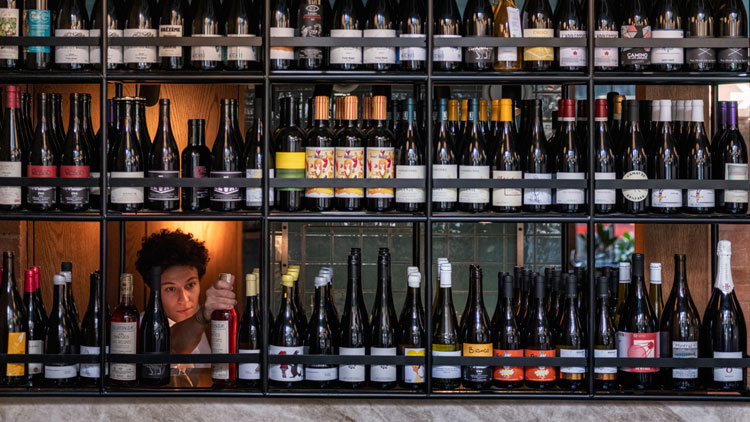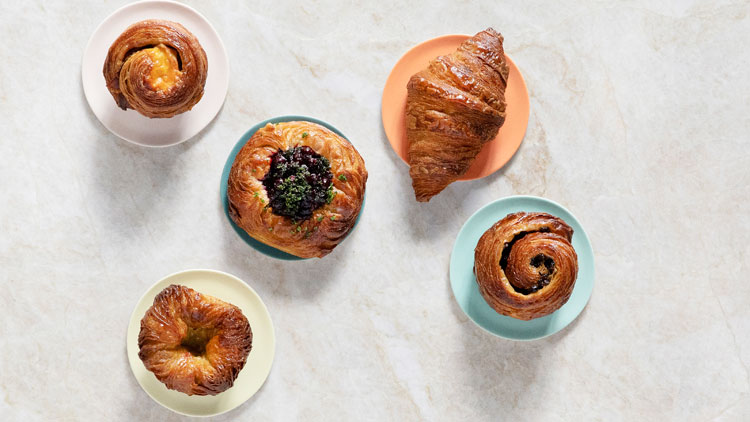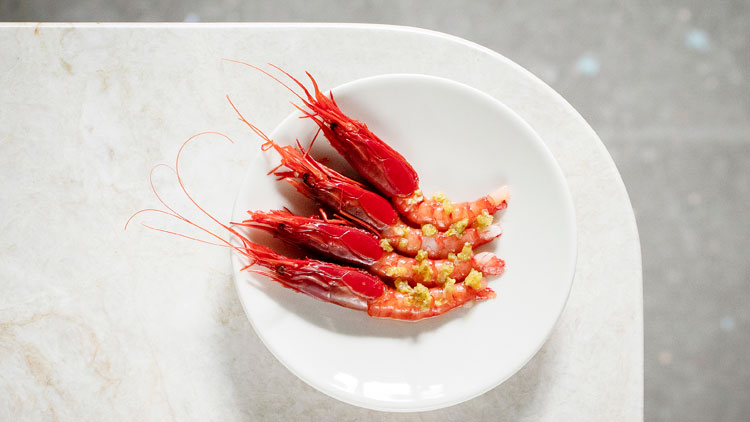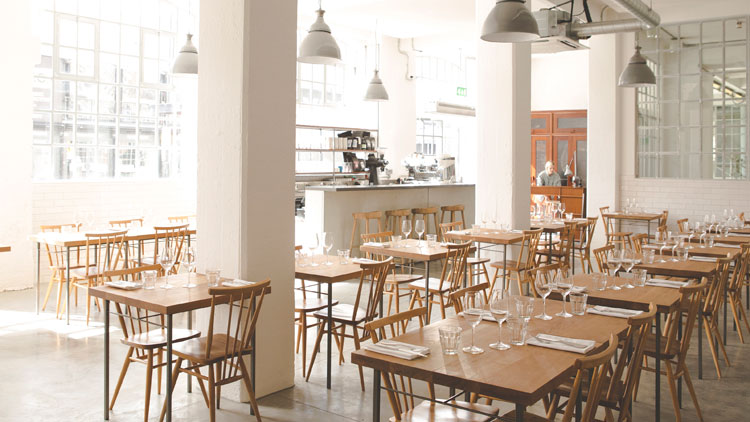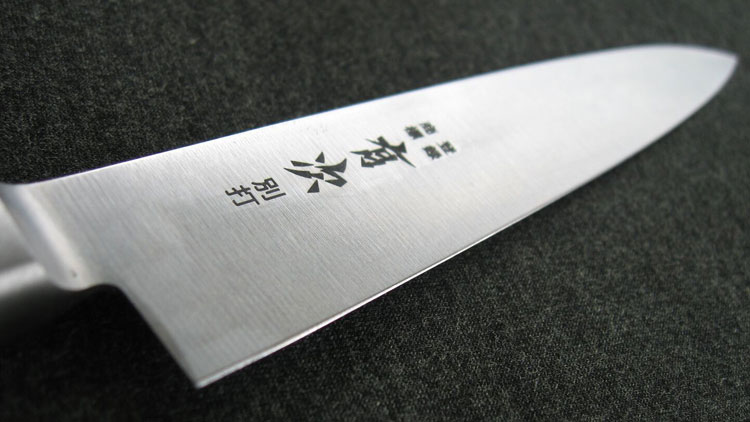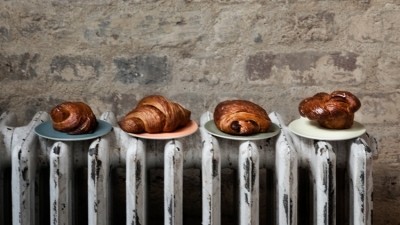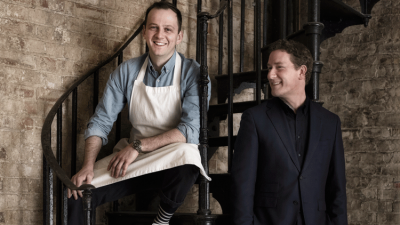Sponsored by Nisbets in Place
Yeastie boys: Lyle’s co-founders James Lowe and John Ogier on their new restaurant Flor
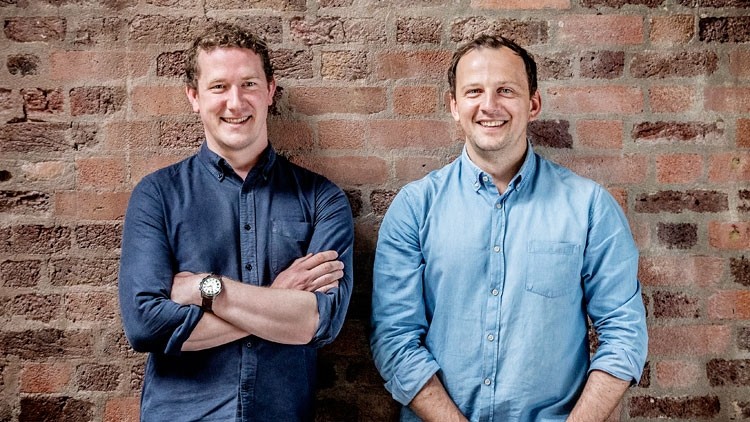
As restaurant spaces go, few are more charming – or likely more challenging – than Flor, the Borough Market restaurant that opens later this month from Lyle’s duo James Lowe and John Ogier. Set across two floors, there is little room to swing the proverbial cat in the ground floor space thanks to its marble-topped counter and open kitchen, while the first-floor dining room space is not much bigger. Access to the floors is via a black cast iron spiral staircase, which is both easy on the eye and treacherous underfoot, particularly so for waiting staff carrying numerous plates and glasses, with access to the rooftop kitchen garden via an even more vertiginous set of steps.
And then there’s the upstairs toilet, also accessed by the spiral staircase, which is basically a box that sits on a mezzanine floor above the dining room. From inside, the wall can be slid back (hopefully not by someone while on the loo) giving the team access to the high-level wine racks that have been built vertically to save space. Quirky doesn’t even come close to describing Flor.
But it’s not hard to see the appeal of the space, either, not least because of its floor-to-ceiling Crittal steel windows, bare brick and concrete walls and rough-and-ready charm. It’s the kind of building that many a restaurateur would pass up based on its size and shape, but which others would instantly fall in love with for the very same reasons. In Lowe and Ogier’s case it was the latter.
“Not wanting to sound totally amateurish from a business point of view but we were pretty much sold on this place by the windows and the staircase,” says Lowe, when the three of us meet at Flor a month before its opening date of 11 July. “Lyle’s [the pair’s debut Shoreditch restaurant] is bigger than we wanted it to be, but we loved the space and knew we just had to win it. It’s the same thing here.”
“Then we win it and panic and try to see how we can make it viable, or at least try and not guarantee that we don’t lose money,” adds Ogier.
“It depends on what your primary driver is when opening a restaurant,” interjects Lowe. “Some people look purely at square footage and go, ‘this is the number of seats, this is the rent, this is how much money can we make’ on the day they view. We look at it as ‘what a beautiful restaurant, we’d love to be here so what can we do to make it work? How much does it cost?’. And then we go ‘oh shit!’ But by then we don’t care any more because we want it and we think we can do something good with it. That’s how we think and that’s why we’ll never make as much money as other people.”
More admirable than likeable
This last point has resonance. When Lowe and Ogier opened Lyle’s in 2014 in Shoreditch’s Tea Building, it was clear from the get-go that they were embarking on a passion project rather than something to boost their retirement funds. Having met while working at St John Bread and Wine in Shoreditch, the pair were very clear from the outset on their vision for their debut restaurant and have been unflinching in their approach; to create a singular space that celebrates the best British ingredients as well as international cooking talent.
The food is considered, sometimes straying into chef geekery territory in some of its ingredients and preparations, other times achingly simple for a restaurant with a Michelin star, sometimes to the consternation of first-time diners. The aesthetic is stripped back, austere even, and the service is cool and calm, but sometimes mistaken as aloof. As such, as it approaches its fifth year, Lyle’s remains one of the capital’s most divisive restaurants; but for those who get it, one of the most exciting.
“Lyle’s doesn’t sit right with everyone who comes,” admits Ogier, noting that while the restaurant does well on lists including the UK’s Top 100 Restaurants (it is currently ranked 17th) and The World’s 50 Best Restaurants (ranked an impressive 34th), it is notably missing from similar listings from The AA Guide and The Good Food Guide. The critics weren’t forthcoming with their praise early on either, with the pair recalling the “panning” it got by Fay Maschler in theEvening Standard and by John Walsh in The Independent, who wrote that it was one of the oddest meals he’d ever eaten.
But it was perhaps AA Gill (as always) who best summed up Lyle’s, describing it as “more admirable than likeable” – words that Ogier and Lowe have never forgotten. “It was hard to swallow getting hit and miss reviews,” says Lowe, “and we are sometimes seen as a little bit cheffy and cold, but it’s made us who we are.”
What this amounted to in the early years was a restaurant of strong pedigree – Lowe had already shown himself to be a brilliant cook, not only as head chef at St John Bread and Wine but also alongside Isaac McHale as one of the Young Turks doing various pop-ups – but that was nonetheless not universally loved, as the balance sheet bore witness. Set up in partnership with JKS Restaurants, the group behind Indian restaurants Gymkhana and Trishna that has also invested in restaurants including the now two-starred Kitchen Table, the one-star Sabor and Bao’s growing portfolio of Taiwanese restaurants, and with Ogier and Lowe investing all of their savings into the project, the Lyle’s of today almost didn’t make it after running at a loss for the first 18 months.
The pair carried on regardless, and at the start of 2016 the upturn finally began. “We were getting to a point where we should either change what we were doing or go bust, but then just squeaked over in January for reasons unknown to us,” says Ogier. “We stopped losing money, and when you’re sticking to your guns and not losing money, it’s a nicer place to be.”
"Lyle's is sometimes seen
as a bit cheffy and cold,
but it's made us who we are"
Controlling their destiny
Lowe and Ogier knew at the time that Lyle’s was something of a risk, but one they wanted control over. This, they say, is why they teamed up with JKS. “The reason we went into a partnership is because John and I didn’t want to open a restaurant just with someone giving us a million pounds – we wanted to have skin in the game,” says Lowe. “If you have backers and things aren’t working, you can be pressured into doing things you don’t want to do. We put everything we had into the restaurant because we never wanted to be in a position where our hand was forced.
“We’ve not paid ourselves very much, but if we had taken the money from investors and a big salary there’s a chance that if we were in the same position we’d been in year one, we may have been booted out or told to change. You see this all the time – a good chef sets up a restaurant, and then you find out where the money’s come from. Four months in and they didn’t get the reviews they wanted and all of a sudden they’re told ‘it’s not making enough money let’s turn it into a bar’ and they get shafted. Not everyone can put in money like we did, but we wanted to make sure we could do what we wanted.”
JKS has also been very understanding. Ogier admits they had been on the verge of having some “very frank discussions” about the restaurant’s future, but that they got the support they needed. “They pretty much questioned us as to why we were doing something. This was a good process as we had to sit and justify it, which often reinforced our belief that we were doing the right thing. But there was never any real pressure. There are very few people with as diverse a restaurant portfolio as JKS – they put faith in people.”
Taking a different tack at Flor
Back to Flor. With their second venture the duo have again buddied up with JKS, having invested the profits from Lyle’s over the past five years (or more realistically the past three years, given its slow start) with JKS topping up the pot. It’s a neat arrangement, particularly given that JKS is not averse to helping its partner restaurants grow – was it always on the cards?
Not according to the pair, who insist there was never any real appetite to look beyond Lyle’s. It was only when they discovered that the small site next door to their restaurant was on the market (now home to a Dirty Burger) did they start to consider branching out, and then only in a very modest way.
The idea was to run a 20-cover operation making use of the large back-of-house space at Lyle’s, including its large basement, with the pair putting together a pitch for the site based on this premise. It never came to fruition, but by then they had become increasingly excited about what they could do, and other landlords had become interested in what they were proposing, with the site in Borough Market being tabled.
Not having Lyle’s back-of-house space at their disposal has meant a slight change of tack, and Flor is more accessible than its more esoteric older sibling. But it’s no less ambitious given the tight space, opening for breakfast, lunch and dinner and doubling as a bakery that will supply bread for both restaurants and a little for retail.
Menus are yet to be fully finalised (Lowe admits to being a last-minute kind of person), but its early morning offer will focus on pastries, created by Lowe and Lyle’s hugely talented pastry chef Anna Higham, with options to include seasonal Danishes, a raw cream bun, brioche filled with sourdough caramel, and a birch syrup version of the Breton pastry kouign-amann. There will also be a pastry made with pork fat – a delightfully fatty and caramely concoction that is both sweet and savoury. At weekends, brunch will be served, with dishes such as coddled eggs with trout roe and za’atar; and eggy bread with maple and black pudding.
Lunchtime options, meanwhile, will also draw on the bakery element, with a mangalitsa and comté sandwich in fermented potato bread; and flatbreads with raw artichokes and bottarga; and with crushed peas, sliced and frozen lardo, pea shoots and lovage oil featuring.
The dinner menu will be more in step with Lyle’s, with dishes including burrata, grilled bread and salted tomatoes; lamb ribs with yoghurt and black lime; and pollack brandade with pickled peppers. Plates are designed to be small(ish) although larger ones to share, such as whole dover sole with capers and marjoram, will make an appearance.
“The aim is to be accessible,” says Lowe. “We’re a casual restaurant where you can have some pastries for breakfast or some small plates and a glass of wine at lunch and a bigger dinner in the evening. It feels like its home should be in Borough Market.”
"We were getting to a point where
we should either change what
we were doing or go bust"
A change of scene
That said, Borough Market is a very different beast to Shoreditch, not least that it has a much more transient and tourist population. How has this influenced their approach? The reality is that although the pair recognise Flor will be very different to Lyle’s, exactly how it will take shape remains fluid.Flor’s opening times, for example, are subject to tweaking once the restaurant hits it stride. Though described in the press release as being open all day, Ogier and
Lowe say that Flor will close between lunch and dinner to take the pressure off the kitchen. Quite when it will reopen for dinner is also up for discussion, with 5.30pm and 6pm being mooted. “When you say you’re not entirely sure about something people think you are a bit clueless and don’t know what you’re doing,” laughs Lowe. “Yes, we know a bit about Borough Market but only when we are embedded in it will we get a better idea of how it works. We might find everyone wants to come at five and we’ll maybe close a bit earlier. Maybe that’s a bit risky.”
The mix between tourists and more dedicated diners is also something they know they will have to manage. Flor will need to attract market visitors looking for a sit-down bite to eat as well as those looking for a more destination restaurant. Despite its diminutive size, and out of step with the approach of some of the other nearby restaurants of similar style, it will therefore take reservations.
“I’ve got a young family; would I go to a restaurant where you had to queue for an hour? No,” says Ogier. “It would therefore be a bit disingenuous to open a restaurant that is only walk-ins. As with the menu, we need to try to be as accommodating as we can.”
“I really don’t understand this obsession with having exclusively walk-in or reservation restaurants,” adds Lowe. “An ideal restaurant is where you can book ahead and guarantee a table but if you turn up in town late you can also get a table. I don’t know why you’d deviate from that.”
How the numbers might stack up is also yet to be fully finalised, the pair reveal. “People keep saying ‘who’s going to eat here? ‘How long are they going to be here for?” says Ogier. “Have we worked out average spend yet? Err, if JKS are reading this then yes, of course we have...!” “Yes, we’re just finishing the budget,” adds Lowe with a grin. “It’s our primary concern.”
Fastidious sourcing
If you’re JKS you don’t form a partnership with Lowe and Ogier based on their business acumen or way with numbers (which is not to say they have none). What they might lack in hard-nosed financial wherewithal they more than make up for in dedication to their craft, with Flor set to follow in Lyle’s footsteps with its obsessional approach to sourcing, sustainability, animal welfare and ingredient quality.
For example, they say they have been pushing their wine suppliers hard for a long time to work on allocations of interesting wines that are accessible but also available in large formats. Many will be by the glass and all will come from agriculturally responsible producers, in line with all the suppliers they deal with. And many will be fascinating drops: Flor takes its name from yeast that naturally forms on some wines and Lowe says wines made under flor have a characteristic that is amazing with food.
Then there’s Flor’s bakery element, which has been a long-term project for Lowe. The kitchen uses a stoneground strain of heritage wheat which has been milled at Lyle’s from the very beginning. It makes for less pretty patisserie, he says, but can’t be matched on flavour.
“Something people might struggle with is that the bread and pastries won’t look as nice as if we’d used a higher protein, newer strain of wheat because it lacks the gluten and protein. We’ve all seen pictures of a loaf cut in half and full of perfect bubbles; we’ll never be able to make bread that looks like that because the flour isn’t strong enough. But on the flip side, that beautiful-looking bread will never taste as good as ours does – it can’t. That flour is bred for strength not flavour; we are using things bred for flavour.”
For this reason, Flor’s croissants won’t be “beautifully white” because the flour hasn’t been bleached. “People might think that looks a bit weird, and we may struggle with expectations, but we won’t compromise.”
And what of the mangalitsa pork fat bun? “It’s not lardy cake, or a kouign-amann or a croissant, it’s a mix of technique. We ask ourselves ‘what do we want it to be? Who does that sort of thing well? Can we borrow an ingredient from here or a technique from there and make something that’s ours?’”
Naturally, this ultra-fastidious approach to sourcing impacts everything the restaurants will now buy. Lowe discusses a potato epiphany he had when he tasted some new potatoes from a farmer last summer. “We use potatoes throughout the year, then four and half years into the restaurant I tasted these potatoes and from now on we will only serve potatoes if we can get them from this farmer. This is what happens with so many of our ingredients.”
Lyle’s now only uses chicory grown in northern France “because it is much better than the alternative”, he adds. “It takes a long time, we have to investigate everything on our menu throughout the year. That’s a lot of work.”
Some might dismiss this approach as over the top, others as unnecessarily geeky, but it is the very essence of Lowe and Ogier’s approach. And they are never going to change.
“Our big concern is doing something we don’t completely believe in,” says Ogier. “We want to work with people who make us better – and to do that we need to create spaces that excite both our customers and people who work with us. If, in 20 years’ time, something like that has happened and we’re still here, then great. We just want to be true to ourselves.”
This is a web version of an article that first appeared in the July issue of Restaurant magazine, the leading title for the UK's restaurant industry. For more features, comment, interviews and in-depth analysis of the restaurant sector subscribe to Restaurant magazine here
Be my guest: how Lyle's brings global gastronomy to Shoreditch
A key pillar of Lyle’s is the restaurant’s Guest Series, where Lowe invites up-and-coming chef talent from across the world to cook in his kitchen for special one-off meals. What started as a series of pop-up events following Lowe’s departure from St John Bread and Wine has become a permanent fixture of the restaurant, designed to give its customers the opportunity to experience some of the world’s best restaurants without the airplane fare.
“I really enjoyed the collaborative process but craved to be in my own bricks and mortar place,” says James Lowe. “But when we found Lyle’s I realised I didn’t want to lose it. A lot of people do [collaborations] because they have to, but I wanted to keep it going.”
Such was Lowe’s desire to collaborate that the small kitchen at Lyle’s has been designed with a wide pass so that it can cope with having many chefs at it at the same time (there were 20 in the kitchen for a recent Gelinaz dinner).
Flying in chefs from around the world and putting them up in hotels is an expensive business, and – true to form – Guest Series lost money for the first two and a half years. Yet the pair resisted bringing over big name chefs to help secure sponsorship because it didn’t tally with what they were trying to do, which was engage with a new generation of chefs they greatly admired.
“In the early days people were telling us we needed bigger chefs, but that’s not what we want. We’ve been good at selecting people who get it. We’ve never invited any mega fancy chefs because we’re not a fancy restaurant.
We pick people who are interesting. But it’s about building trust because people book but don’t know what they are going to get. They likely won’t have heard of the chef or their restaurant, but they’ll think that if it’s at Lyle’s, it will be good.”
A look at the previous Guest Chef collaborations is a good indicator of chefs across the world to keep an eye on. Lowe points out that Daniela Soto-Innes, the chef-partner at New York’s Cosme restaurant who was named this year’s Elit Vodka’s World’s Best Female Chef, cooked at one of the events at Lyle’s three years ago. “I’m not surprised that’s she’s now a star, she’s amazing.”
As before, sticking to their guns eventually paid off. Not only does sponsorship now cover the costs of travel and accommodation but
the pair believe that everybody benefits from its Guest Series.
“It’s of fundamental importance for the restaurant to carry on experiencing new things and different people’s perspectives. It has always been about learning and interacting with super-talented people from all over the world,” says John Ogier. “It has developed the restaurant more than anything else.”
“I consider flexibility and adaptability to be really good qualities in chefs,” adds Lowe. “One of the things I really want is when people leave Lyle’s and go somewhere else is them walking into a kitchen on their trial shift and people thinking ‘they’ve had two years at Lyle’s, that’s why they are staying calm’”.
Five pieces of professional kitchen kit James Lowe can’t live without
Polin bread ovens
We’ve been making bread at Lyle’s since we opened. It’s one of the first things a chef learns about when they start at the restaurant. It’s so important – the ability to transform three humble ingredients with the right approach to sourcing, time, technique and temperature into something amazing is key to understanding our approach in general. We’ve always used a convection oven, the results have been good, but I’ve always known they could be better with the right ovens. I am looking forward to taking the baking and viennoiserie to a new level with our amazing pastry and baking team, and the aid of our new deck ovens at Flor.
Black iron frying pans
There is something so beautiful about how simple, heavy and dependable these pans are. I love that if you maintain them and keep them seasoned they will last and remain non-stick forever. They’re not even that expensive but so important in the kitchen.
Grill
The grill at Lyle’s is so central to the food, it has always given so much character to the menu. It’s quite a large grill but we use fire bricks to alter the shape of the pit depending on what we want from it. We’ve used all sorts of charcoal, wood, binchotan and ogatan logs on it in the past five years, depending on what we’re grilling and the sort of results we want to get. It’s been fascinating to watch all the guest chefs we’ve had over time use it in different ways. It keeps us constantly reassessing how and why we do things, which I think leads to constant learning and development.
Aritsugu knives
Some chefs have a huge collection of knives, most of which they never really use. I love that you can do just about any job in the kitchen with two knives: a cook’s knife and a utility knife. The third, a slicer, is a nice add-on. My first Aritsugu is about 12 years old, bought for me by a Japanese pastry chef we had at St John Bread & Wine. I have since managed to get one each time a friend has visited Japan. The last one I bought when I finally went for the first time myself, about seven years ago.
Japanese strainers
I was so inspired by my first trip to Etxebarri about 10 years ago, more than the food it was the customised kitchen equipment that really stayed in my mind. One such item was a frying pan that had many small holes drilled in to it. They used it as a ‘saute’ pan that was directly above the coals so that chef-patron Victor Arguinzoniz could cook and use the smoke and flare from the grill to add flavour to the item being cooked. I started using mesh strainers to do a similar thing but they would always get crumpled and split – they were badly made and not up to the task. On my first trip to Japan I found something that looked like any average strainer but the grade of steel seemed much higher, it didn’t have any flex in it. I bought about four back and they’ve lasted years.
Discover how Nisbets can help you keep your house in order: visit inplace.nisbets.co.uk
